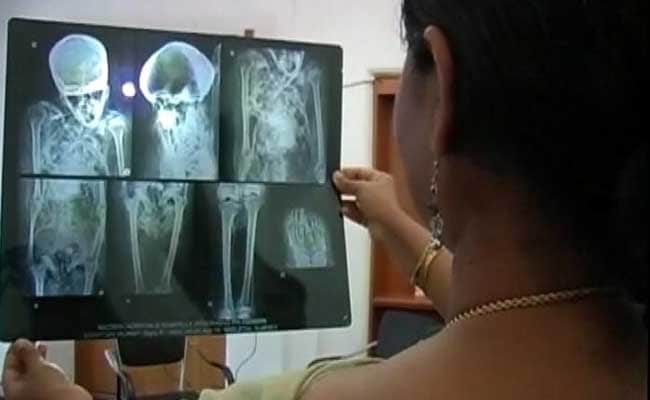
The mummy was obtained by sixth Nizam Mir Mehboob Ali Khan in 1920. His son and last Nizam Mir Osman Ali Khan donated it to the museum, where it has been kept since 1930.
- The mummy of an Egyptian Princess was obtained by a Nizam in 1920
- Telangana Museum using new techniques to preserve the mummy
- Team found that the ribs were damaged, parts of the brain still intact
Did our AI summary help?
Let us know.
Hyderabad:
One of the six Egyptian mummies in the country is decaying. To stop its further degeneration, the Department of Archeology has started a project that will be a case study for such conservation across the world.
The mummy --- said to be of Egyptian Princess Nishushu -- was obtained by sixth Nizam Mir Mehboob Ali Khan in 1920. His son and last Nizam Mir Osman Ali Khan donated it to the museum, where it has been kept since 1930.
Initially Princess Nishushu was believed to have died at the age of 16 in the Ptolemic period -- 300 BC to 100 BC. But a CT scan - done on very few mummies in the entire world -- and X-ray examination revealed she was aged around 25 years.
 The team also discovered parts of the brain, which were still intact - a great deviation from the process of mummification.
The team also discovered parts of the brain, which were still intact - a great deviation from the process of mummification.
"One fourth of the brain is left inside. Generally, what we study theoretically is that through nasal hole the brain is taken out," said N Visalatchy, Director of the state museum. "This means there is more scope for scientific research and in fact, we tried to get the data from British museum also. They themselves do not have any."
It was found during the CT scan that her ribs were damaged and there was a slight dislocation of her spine and one ankle. The rest of her bones, skull and teeth are intact. It is likely that a metallic amulet has been placed inside her body, officials said.
"The damage to the mummy had happened due to heat, light, temperature, humidity, insects and oxygen," said Vinod Daniel, Heritage Conservation Adviser to the project. The conservation techniques adopted includes changing the case to an oxygen-free one, which will stop infestation of bacteria and insects and keep away humidity.
The techniques were used for the preservation project here for the first time. It can set an example for conservation of mummies in India and abroad, officials said.

"The kind of techniques they have used... probably one or two museums globally would have used," said B Venkatasham, secretary, Youth Advancement, Tourism and Culture Department. "After the CT Scan and X-rays, the mummy was brought back to the museum and has been placed on the newly-prepared base in the showcase."
The painted cartonnage -- a material used to make the funerary mask -- has been replaced in the proper position and the showcase has been sealed again, he said.
The next phase of the conservation will involve remedial measures and possible restoration of the cartonnage, so it can then be displayed in a special showcase, Mr Venkatesham said.
The mummy --- said to be of Egyptian Princess Nishushu -- was obtained by sixth Nizam Mir Mehboob Ali Khan in 1920. His son and last Nizam Mir Osman Ali Khan donated it to the museum, where it has been kept since 1930.
Initially Princess Nishushu was believed to have died at the age of 16 in the Ptolemic period -- 300 BC to 100 BC. But a CT scan - done on very few mummies in the entire world -- and X-ray examination revealed she was aged around 25 years.

The mummy at the Telangana museum is one of the few in the world that has had a CT scan and X-Rays.
"One fourth of the brain is left inside. Generally, what we study theoretically is that through nasal hole the brain is taken out," said N Visalatchy, Director of the state museum. "This means there is more scope for scientific research and in fact, we tried to get the data from British museum also. They themselves do not have any."
It was found during the CT scan that her ribs were damaged and there was a slight dislocation of her spine and one ankle. The rest of her bones, skull and teeth are intact. It is likely that a metallic amulet has been placed inside her body, officials said.
"The damage to the mummy had happened due to heat, light, temperature, humidity, insects and oxygen," said Vinod Daniel, Heritage Conservation Adviser to the project. The conservation techniques adopted includes changing the case to an oxygen-free one, which will stop infestation of bacteria and insects and keep away humidity.
The techniques were used for the preservation project here for the first time. It can set an example for conservation of mummies in India and abroad, officials said.

The mummy is of Princess Nishushu, believed to have died in the Ptolemic period -- 300 BC to 100 BC.
"The kind of techniques they have used... probably one or two museums globally would have used," said B Venkatasham, secretary, Youth Advancement, Tourism and Culture Department. "After the CT Scan and X-rays, the mummy was brought back to the museum and has been placed on the newly-prepared base in the showcase."
The painted cartonnage -- a material used to make the funerary mask -- has been replaced in the proper position and the showcase has been sealed again, he said.
The next phase of the conservation will involve remedial measures and possible restoration of the cartonnage, so it can then be displayed in a special showcase, Mr Venkatesham said.
Track Latest News Live on NDTV.com and get news updates from India and around the world

